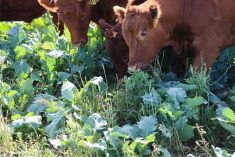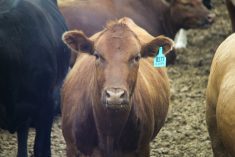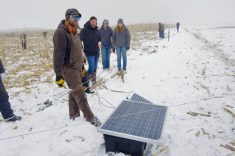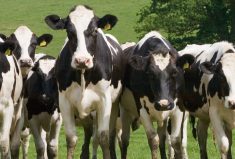It’s been five years since Doug Northam traded in his sloughs for solar, and the Rapid City producer gives his remote watering system glowing reviews.
“Around here we don’t have any wells or anything, so the cows just drink out of the sloughs and when they dry back a bit they tend to be three feet of mud for 20 or 30 feet before you get to water,” he said. “In fact, we did lose one (animal) actually one time — it gets bogged down and can’t get out.”
Read Also

Pig transport stress costs pork sector
Popular livestock trailer designs also increase pig stress during transportation, hitting at meat quality, animal welfare and farm profit, Agriculture and Agri-Food Canada researcher says
Looking for solutions, Northam eventually turned to the Little Saskatchewan River Conservation District and its solar-powered remote waterer, on offer for farmers to demo. Northam was impressed with the results. The piping bypassed the muck that animals would have ordinarily had to wade through, instead bringing water within easy reach of the herd.
The difference was large enough that Northam started designing his own system soon after the demo ended.
Today, Northam’s mobile system services 60 cow-calf pairs and between 55-60 yearlings at a time and is the hub of his mob grazing system. Paddocks are spread in a pie shape around the trough with the single drinking site accessible to all paddocks. The herd will rotate through the whole “pie” before the system must be moved.
“We’ve been rotational grazing for quite a while, but we started with this adaptive, high-density grazing,” Northam said, referencing a grazing style with a large number of animals grazing a small area before moving quickly to a new area, allowing the land to recover. “We try and set the water up so that we can just fan out and we move the cows every day, but we hopefully only move the water about once a week.”
That timeline might change, depending on the frequency of herd movements, he added. The herd is normally moved once a day, but Northam says he switched the schedule to twice-daily moves during some periods this season. Most recently, the producer went through eight paddocks in a week.
“We’ve just sort of placed (the waterer) strategically,” he said. “You sacrifice a small area around where they come back to all the time, but it’s very slick to move. One person could probably pick it up and be out of there in 20 minutes to half an hour.”
Reliable?
Northam has been overwhelmingly happy with his system, despite some experts, including Manitoba Agriculture livestock specialist Ray Bittner, identifying reliability issues with solar-powered waterers.
Duane Kent, who lives northeast of Calgary, agreed that reliability was a concern, but the Alberta producer has little option but to go solar.
Kent is over 500 kilometres away from his pasture near Biggar, Sask., a four-quarter area with no natural surface water that Kent estimates would take at least $30,000 to run power to.
The well and piping were already in place when he bought the land, Kent said, but noted that the previous owners were at the mercy of their water pump, which only kicked in when trough levels were low and meant that water ran out quickly in the case of a problem.
He has since added 3,000 gallons of storage on site, enough for a one-day grace period should he need to make the drive.
“It’s been fairly reliable,” he said. “You’ve got to realize it’s not a walk-away system. You do have to pay attention to it, but at the cost, we couldn’t even begin to run power there.”
Today, Kent runs 100 cow-calf pairs on a two-paddock rotational grazing system, both accessible to the stationary watering system.
The phrase “remote” watering takes new meaning on Kent’s farm. Faced with the need to keep watch over the system and the reality of distance, the producer outfitted his pasture with cameras and synced water system controls to his smartphone.
“One issue that we ran into is if we get too much solar, the pump doesn’t like too high of voltage and it would lock up, so it was just a matter of flipping a switch on and off, which — a five-hour drive to take 10 seconds to flip the switch on and off is not a lot of fun,” he said. “Now, this season, we’ve added a control system that has relays I can control over the internet.”
Solar panels have also seen an upgrade this year. The system previously ran off 12 panels producing 750 watts at a given time. Improved solar technology has allowed Kent to improve those numbers. His system now boasts four panels and produces 1,000 watts.
The change will help deal with those hot but cloudy days when demand for water is high, but solar energy is low, he said.
A battery backup was also added this year and is able to run the system for two days without sunlight.
“The nice thing about the well is we’re not worried about water quality,” Kent said. “This year was bad. There were a lot of dry areas and salt in the water in the dugouts and that became pretty bad.”
Over 200 cattle died in southern Saskatchewan this July due to water quality.




















